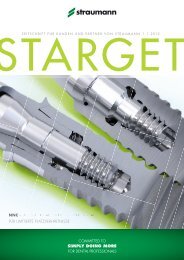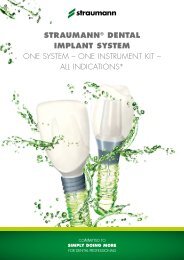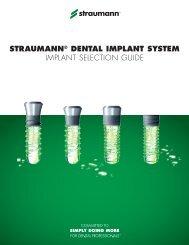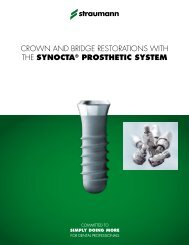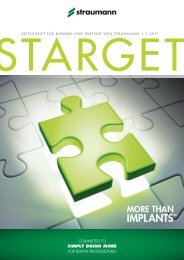Basic information on the surgical procedures - Straumann
Basic information on the surgical procedures - Straumann
Basic information on the surgical procedures - Straumann
You also want an ePaper? Increase the reach of your titles
YUMPU automatically turns print PDFs into web optimized ePapers that Google loves.
4<br />
4<br />
4 mm<br />
Step 4 – Insert <strong>the</strong> implant with <strong>the</strong> handpiece<br />
Move <strong>the</strong> implant into final positi<strong>on</strong> with a maximum of<br />
15 rpm, turning it clockwise.<br />
Note<br />
When <strong>the</strong> floor of <strong>the</strong> b<strong>on</strong>e cavity is reached, <strong>the</strong>re is a<br />
palpable increase in resistance.<br />
Step 4 – Insert <strong>the</strong> implant with <strong>the</strong> ratchet<br />
Attach <strong>the</strong> ratchet and <strong>the</strong> pivot of <strong>the</strong> holding key which<br />
is used for stabilizing. The clockwise arrow <strong>on</strong> <strong>the</strong> rotary<br />
knob signals <strong>the</strong> directi<strong>on</strong> of inserti<strong>on</strong> (see insert). Bring<br />
<strong>the</strong> implant into its final positi<strong>on</strong> at b<strong>on</strong>e level with slow<br />
movements of <strong>the</strong> ratchet.<br />
The top 4 mm cylindrical part of <strong>the</strong> transfer part for <strong>Straumann</strong><br />
® B<strong>on</strong>e Level implants can be used as a depth indicator<br />
(e.g. relative to <strong>the</strong> prospective gingival margin). It<br />
facilitates cor<strong>on</strong>oapical implant positi<strong>on</strong>ing in <strong>the</strong> anterior<br />
area.<br />
Cauti<strong>on</strong><br />
An inserti<strong>on</strong> torque of 35 Ncm is recommended. If 35 Ncm is achieved before <strong>the</strong> implant has assumed its final<br />
positi<strong>on</strong>, to avoid b<strong>on</strong>e overcompressi<strong>on</strong>, check that <strong>the</strong> implant bed preparati<strong>on</strong> is correct.<br />
The transfer piece is provided with a pre-determined breaking point to prevent damage to <strong>the</strong> inner c<strong>on</strong>figurati<strong>on</strong> of <strong>the</strong><br />
implant, thus ensuring <strong>the</strong> integrity of <strong>the</strong> interface for mounting <strong>the</strong> pros<strong>the</strong>sis.<br />
After breakage of <strong>the</strong> transfer piece, <strong>the</strong> remaining part of <strong>the</strong> transfer piece in <strong>the</strong> implant must be removed and <strong>the</strong><br />
implant, if not fitted correctly, has to be unscrewed with a 48h Explantati<strong>on</strong> device. After that <strong>the</strong> implant bed is to<br />
be re-prepared and a new implant has to be inserted. For fur<strong>the</strong>r details, please c<strong>on</strong>sult <strong>the</strong> brochure “Guidance for<br />
implant removal” 152.806.<br />
48<br />
4. Surgical <strong>procedures</strong> 4.3 Placing <strong>the</strong> implant






